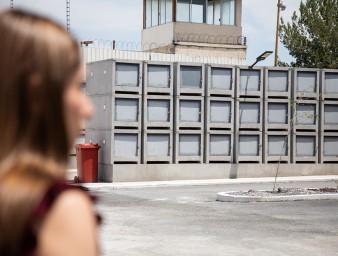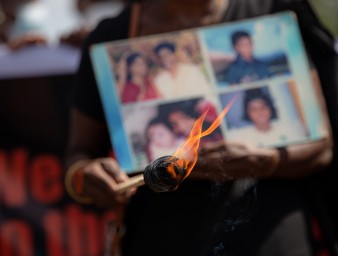Protecting women from the impact of enforced disappearances
14 December 2012

It all started with a group of 14 women who wanted to know where their sons and daughters were; whether they were alive or dead. They wanted to know the truth: when, why and who made them disappear.
These inconsolable mothers marched on Plaza de Mayo in Buenos Aires, Argentina, on 13 April 1977, determined to keep asking questions until they received answers. They inspired a movement of human rights defenders against enforced disappearances that would reach far beyond the countries under dictatorship in Latin America.
Enforced disappearances occur when, with the involvement of State authorities, a person is forcibly removed from public view and his or her whereabouts is intentionally undisclosed. As a consequence, victims are placed outside the protection of the law. In most cases, the only verifiable information provided will relate to the circumstances in which the victim was last seen alive and free.
The international mobilization against enforced disappearances prompted the United Nations to establish a Working Group on Enforced or Involuntary Disappearances in February 1980, the first UN thematic special procedure, which was mandated to foster communication between the families of the disappeared and State authorities to gather information on the fate and whereabouts of victims.
To date, the Working Group has transmitted to Governments over the world more than 50,000 cases. It also worked for the adoption by the General Assembly of the Declaration on the Protection of all Persons from Enforced Disappearances in December 1992, as well as the International Convention against enforced disappearances in 2006.
Twenty years after the Declaration was adopted, women continue to bear the consequences of the enforced disappearances of their loved ones. The protection of women from this practice and its impact were discussed at a recent event to commemorate the 20th anniversary of the Declaration, organised in cooperation with the Organisation Internationale de la Francophonie.
The Deputy High Commissioner for Human Rights, Kyung-wha Kang, noted that women were often left to bear the social and economic impact of the disappearance of families’ main breadwinners. Women, she added, are increasingly subjected to enforced disappearances, at times because of their active role in civil and human rights movements. They are particularly at risk of sexual and other violence during their disappearances.
“In societies where gender-based discrimination in laws and policies hinders the full realization of the human rights of women and limits their autonomy and participation in aspects of public and political life, the social and economic impact of disappearances is felt more strongly and, in turn, renders women and their children more vulnerable to exploitation and social marginalization,” she said.
The Chair-Rapporteur of the Working Group, Olivier de Frouville, said that the Declaration enabled the international community to officially recognize enforced disappearances as a denial of the legal personality of the individual, as well as the specificity of the suffering inflicted on the families and friends of the disappeared. He added that the victimization of women as a result of enforced disappearances was one of the first and persistent challenges the Working Group had to face.
“Throughout its thirty years of existence, the Working Group has faced a challenge: in its first report in 1981, the Working Group noted that it had received allegations of disappearances of women and especially pregnant women. For Argentina alone, the Working Group mentioned more than 60 cases of disappeared pregnant women,” he said. “With the Declaration the unutterable is uttered, the unimaginable is described, and the remedy for the evil is outlined.”
The experts examined how to best protect women from the impact of enforced disappearances. Christos Pourgourides, former Rapporteur of the Parliamentary Assembly of the Council of Europe, said that the suffering of the relatives of the disappeared should be seriously considered.
“This concerns both procedural rights, such as the right to be a civil party in the criminal investigation which should naturally follow all cases of enforced disappearances, and substantive rights, such as those to the truth and to proper compensation,” he said.
Sarah Fulton of the NGO Redress stressed that understanding and coming to terms with what happened to the disappeared is crucial in empowering those most affected by or at risk of human rights violations, as well as framing measures for prevention.
“The empowerment of women through the taking of positive and special steps to enable their active participation in processes that affect them is an essential component of a reparations process that affirms and restores dignity, and leads to the hope of lasting change,” she added.
Aileen Diez-Bacalso, of the Asian Federation against Involuntary Disappearances, devoted her life to fighting against enforced disappearance after a loved one was subjected to that practice. She highlighted the role of women in the struggle against enforced disappearances.
“Witnessing steadfastly amidst the dark night of the disappeared, women victims of enforced disappearances in Asia, as in many parts of the world, have become a formidable force. They founded associations of families of the disappeared in their search for mutual strength and solidarity in finding their loved ones,” she said. “Refusing to be cowed by the horrors of enforced disappearance, they muster all their innate strengths and in the process, transform themselves from pathetic victims to human rights defenders.”
The President of the Euro-Mediterranean Federation against Enforced Disappearances, Nassera Dutour, whose son has been disappeared since 1997, also acknowledged the countless women that continue to bear the brunt of enforced disappearances everywhere.
14 December 2012

VIEW THIS PAGE IN:



